|
Ancient India's Emperor Priyavarta Invaded Arizona!
by Gene D. Matlock
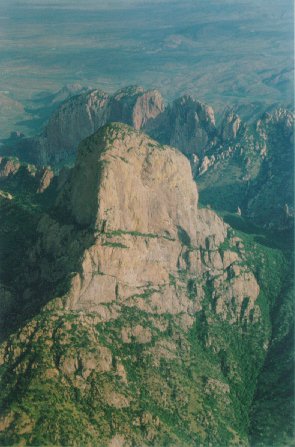
The O'odham term for coyote or dog is Ban. Ban Cheoji = Coyote Men. Edward Moore, in The Hindu Pantheon, wrote: 'Iswara is said... to have descended on earth after a great deluge, from which few escaped, to restore arts and sciences to the race of man that had become ignorant and brutal, and even without a regular language.'(p. 45.) The O'odham myths mention that this happened with their god I'itoi and his coyote men. They say that I'itoi and his coyote men had already sailed around the world three times. On the fourth voyage, they were caught in the flood. The oceans of the world fairly boiled. I'itoi, Siva, or Sewa, and his coyote crew managed to sail back to the port of Punto Peñasco, Sonora, the original name of which was and still is the Pinacate mountain range. In the O’odham language, Pinacate means stinkbug. But in Sanskrit, Pinaka means Shiva’s Trident. Khatti means Phoenician. Pinacate is indeed composed of three volcanic plugs called Schuk Toak or Schuk Daag (Santa Clara or Pinacate Peak). In Turkic dialects, Shikha or Sak = Fire Peak; Dag/Dak = Mountain. As you can easily see, even a child can recognize the Turkish and North Indian origins of those words. The three major volcanic cones in the Pinacate mountain range are now known as El Trebol (Clover), El Colorado, and El Elegante. 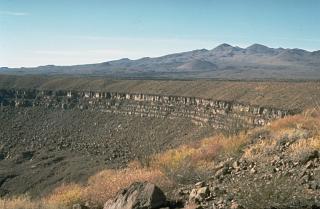
Pinacate Mt. Range In ancient times what is now the Sea of Cortes went up to the base of El Trebol, El Colorado, and El Elegante. But the sea has since backed up miles away. The photo above indicates this. The original beach in the foreground is still visible. When Shiva (I'itoi) and his Ban Cheojis dropped anchor there, they waded ashore and immediately marched inland to Baboquivari and Superstition mountains to help their people get back on their feet. They were also helped by Spider Woman (Durga), so named because she had six arms. Even today, several American Indian tribes worship Spider Woman (Durga) and Coyote Man (God Shiva). Baboquivari Mountain is, indeed, the O'odham equal of Mt Meru or Mt. Kailasa in Western Tibet. India's Shiva and Kubera (god of gold and riches), According to Hindu mythology, and countless numbers of cobra protectors live within Kailasa. Many authorities lnsist that Shiva and Kubera are one and the same deity. However, in Arizona, Quivera (Khyber, Kheever, Kubera) is the mountain. I'itoi (A Phoenician name), Sewa, Sua, or Siva, live within it. Baboquivari is also working alive with rattlesnakes. Many adventurers tell me they are afraid to climb it. The Baboquivera Mountain Range is filled with gold. Virtually all the gold panned in Southern Arizona leaks from the Baboquivari Range. For the O'odhams, Baboquivari is The Navel of the World just as Meru and Kailasa are for the Hindus. 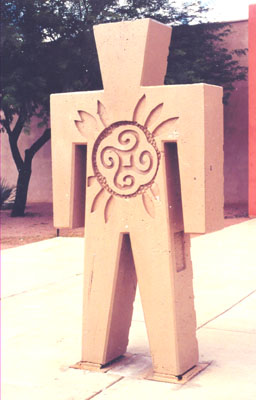
The O'odham representation of I'itoi or God Shiva. Notice the Swastika, a major symbol of Shiva. In India, Babo or Babu means grandfather or wise one. Among the O'odhams, Babo means grandfather on the mother's side. The Turkic and Sanskrit words found in the O'odham nation are too numerous for me to include in this article. I would almost need a book to do that. However, I will just name a few more: The O'odhams call their way of life Himday. The Apaches are Inde. The other puebloan tribes are Inday. Each O'odham district is divided into units called Chek-Shani. Chek = boundary; domain; border. In North Indian dialects Shek = A large division of a country. Shan = Nation. Three O'odham clans are as follows: Sobai-Puri = Skt., Sabha-Puri or Place of the Religious Assembly. Puri also means river. The Sobai-Puri were leaders of the O'odhams in religious and mundane matters. There was also a Sobai-Puri River. It is now the San Pedro. Because the Sobai-Puris were so intelligent and cooperative with the Spaniards, they were removed from Arizona and taken southward to help the Spaniards Christianize more wild and savage tribes. Hya-Sed. In Sanskrit, Hya Siddhi-The Highly Accomplished Phoenicians. Quiburi village. It's Indian equivalent would have been Khyber, Quivari, or Kubera. Gita or Kita, O'odham sacred song. The O'odham word for standing or sacred water is Bac/Vac. This word also derives from Sanskrit. 'Brahma was born out of the golden egg, produced in the boundless causal waters. His consort, VAC, (Saraswati) was manifested out of Him. From their union were born all the creatures of the world. 'The Indian concept of a river is that of a sustaining mother, a fertility goddess and both a physical and a spiritual cleanser. Respect for the river Goddesses was deeply rooted among the people of the Vedic age. Numerous hymns to Sarsvati (Bag Devi) are to be found in the Rgveda.' (Saraswati,by Chirralekha Singh; pp. 8-9.) It is interesting to note that this concept of Vac, Wahka, Wahk, Bak, is found by the exact sound in nearly all the archeological ruins of both Americas. The Smithsonian Bureau of Ethnology once published the titles of ancient O'odham leaders. Each was a name of God Shiva, including the word Teo. 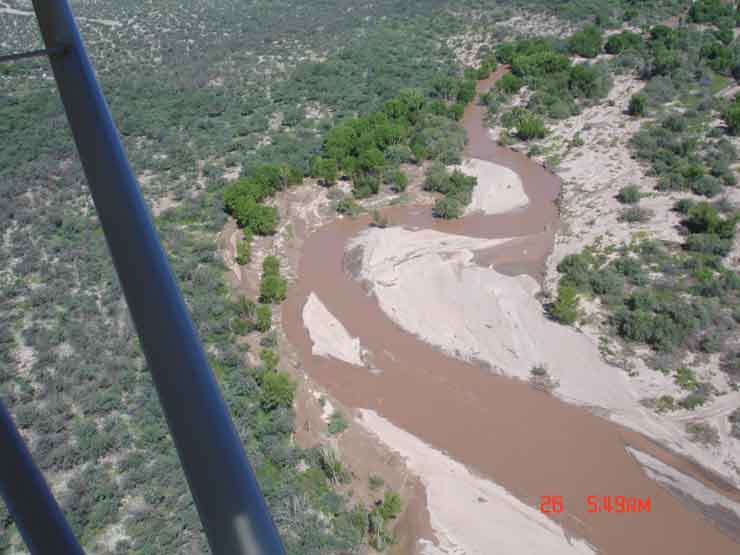
Aerial View of the Sobai-Puri (San Padro River.)
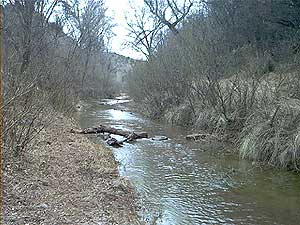
Babo-Comari (Grandmother Mother Goddess) Creek. A tributary of the San Pedro River or the Quiburi region. Kumari is a Hindu mother goddess presiding over fertility, water, and other functions of Nature. According to Hindu Mythology, the first king of the world was named Priyavarta. The world then consisted of thousands of small republics without a central power. Priyavarta sent his armies to all the countries of the world, to unite all Indians and their colonial possessions as one nation. He appointed his sons as viceroys. One son, Sevana or Sewana, was sent to conquer and govern North America. O'odham legends mention this Sewana whom they call Siwana. When Shiva (I'itoi) wouldn't submit to Priyavarta, the former and Siwana met on the battle field. Ultimately, I'itoi (Sewa, Siwa, Se-a, etc) prevailed; Siwana was killed. Even more startling is the name of the O'odhams themselves: Uttama (a common way O'odham is pronounced), was a son of Priyavarta! Since this Hindu legend is confirmed in O'odham mythology, we have sifted out some solid and valid history from the chaff, that no academic can deny.You may want to inquire whether Priyavarta's name ever appeared in the O'odham legends. They did not, for Priyavarta himself did not go to America. Only his sons and their armies went abroad to unite the colonies into one nation. Sivan or Svan people are found all over North America, such as Suwanee, Swanee, Siboney, Siwana, Sewana. There are dozens more of examples that I can provide. I go so far as to say that before English and Spanish nearly destroyed the original O'odham language, O'odham was a Sanskrit dialect. The O'odham legend states that the ancient Hindus even came occasionally to America in a type of dirigible jet craft called Nah-Beg. Nah-Beg derives from the Sanskrit Nag-Bagh, meaning Snake God. Once, one of those Nah-Begs got out of control, swallowing several men alive in its intake manifold, in the lake in which it was moored. That lake, now bone dry, is located in the small village of Quitovac (Skt; Khatti-Vac [Lord of Sacred Waters]), Mexico, just across the border from Southern Arizona. The Shiva or I'itoi at that time, the leader and mining engineer living in Baboquivari, had to go to Quitovac and remove the energy source which was two small green stones containing a powerful and inexhaustible supply of energy. He also brought out alive the six men it swallowed. For many years, the O'odhams kept those stones in caves. The positive charged stone became lost over the years. However, one O'odham family kept the negative half of the energy generator in their home until the 20th century. Edward H. Davis, author of a small booklet published in 1920, wrote that he met an old O'odham man who had seen the negative half of the generator. (Indian Notes and Monographs; Vol. III, #4; The Papago Ceremony of Vikita, puiblished by the Museum of the Indian Heye Foundation, p. 62.) This powerful stone was small. The old Papago Indian told Davis that it was the size of a baseball. Later in the twentieth century, the O'odhams decided to hide it in a grotto in Organ Pipe Cactus Park. No one knows where it is anymore. The O'odham story of the Nah-Beg seems to support the Hindus claim that they once had airships. The O'odhams celebrate the pacification of the Nah-beg each year in a special sacred song fest (Gita), called Vi-i-kita or Vi-i-Gita. This is a Sanskrit expression. Vi = attack; assail; punish; avenge; bring help. I = of; Gita=sacred song. 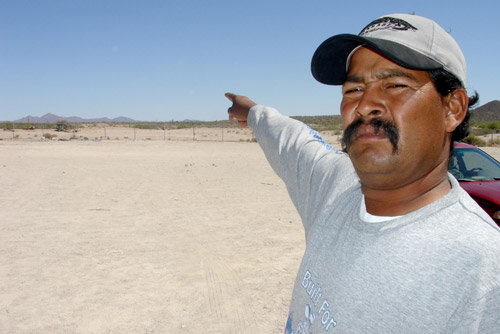
An O'odham man points toward the sacred site where the Nah-Beg got out of control I have no way of knowing whether the O'odhams moved down to Southern Arizona and Northern Mexico from the Arctic Circle or came to America from East to West via the trade winds between the Tropics of Cancer and Capricorn. However, they and the other tribes in the area told the Spaniards that they had come from the north. Little by little, as their memories of their North Pole or Siberian paradise got hazier and hazier, the refugees from Eden, in whatever part of the world, came to identify all their spirituality, traditions and ideas about life with their new homes. That's why we all see ourselves as different from one another and even antagonistic. And when someone says we are really the descendants of Turks and Hindus, we yell indignantly that we're anything but! Meru and Kailasa was said to be guarded by poisonous serpents. Archeologists tell me that Baboquivari has an abundance of rattlesnakes. Mountains like Baboquivari exist all over the world. In Mexico, Mt. Orizaba (Citlalteptl), in Veracruz, is the Aztec and Mayan Meru or Kailasa. The Egyptian pyramids are called M'ru. Mt. Shasta, in Northern California is a Meru or Kailasa for the tribes in that region. It has even become holy for White Americans. Mt. Fuji in Japan is the Japanese Meru or Kailasa. These holy mountains are reminders of where all humans originated -- The North Pole! Comments: |
